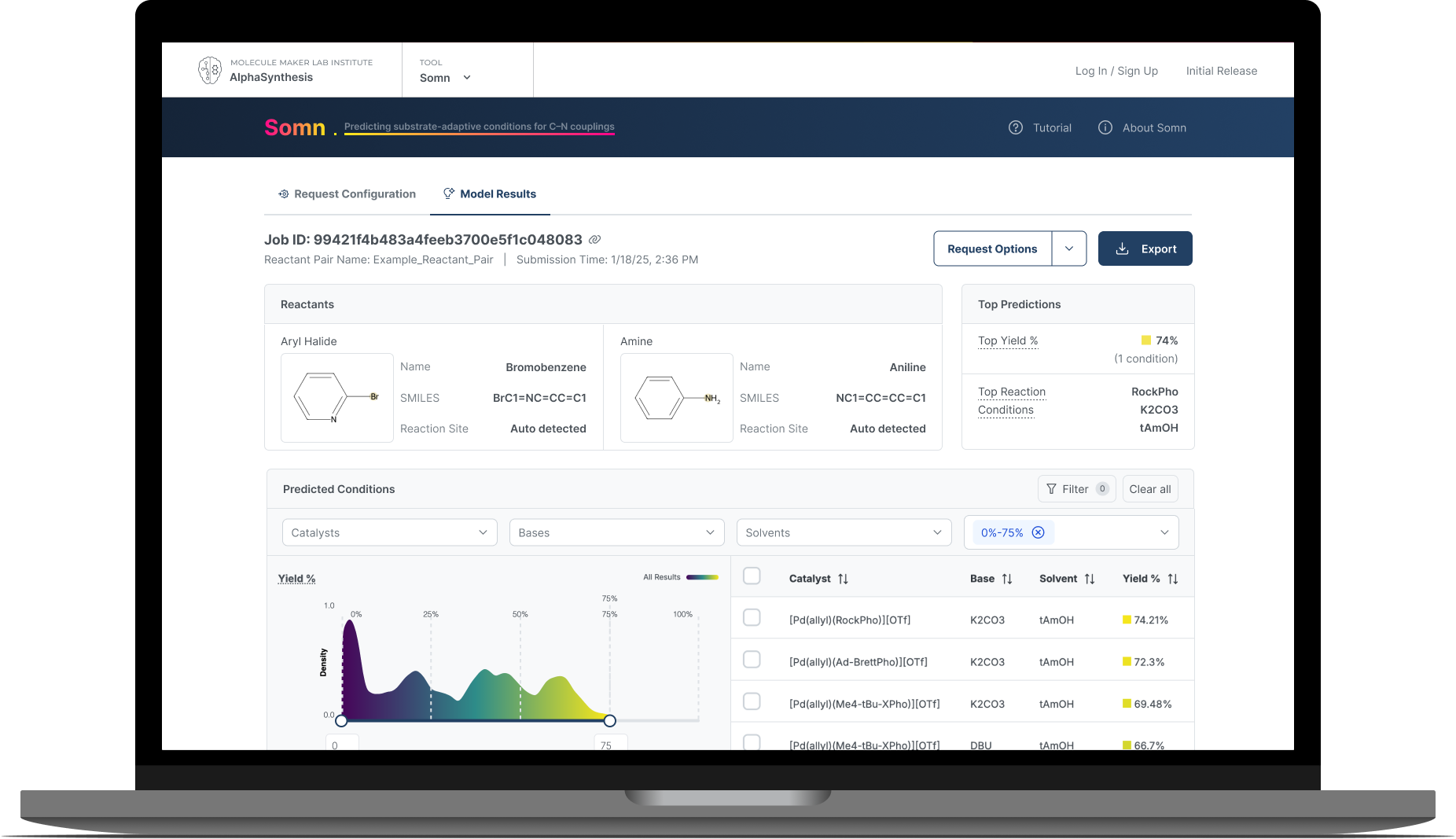Somn
UX RESEARCH | UX DESIGN | UI DESIGN
The Molecule Maker Lab Institute (MMLI) is a pioneering initiative that leverages AI, ML, and chemistry expertise to accelerate and democratize molecular innovation. A core component of this effort is AlphaSynthesis (A/S), a collection of open-source software that streamlines chemical workflows through planning, discovery, and optimization. Somn, part of the A/S suite, is a predictive tool that accelerates chemist workflows for C-N coupling reactions, a process widely used in pharmaceutical research and manufacturing. I led the design of Somn’s user interface, from discovery to handoff, transforming an early command-line resource into a more usable and efficient solution.
DISCOVERYPositioning Somn at intersection of machine learning and chemistry research
Traditionally, chemists have relied on time- and resource-intensive experimental campaigns to identify optimal reaction conditions. Our clients, machine learning researchers, developed an initial command-line tool to predict useful reaction conditions, bypassing this process. They envisioned a graphical interface that would make this technology accessible to a broader audience. To ensure this solution would align not only with technical requirements but also user needs, we conducted literature and code reviews and analyzed competing tools, identifying painpoints and opportunities in the chemical prediction space. Users would need intuitive input methods and clear result displays in order to efficiently evaluate reactions. Guided by these findings, we created user stories, task flows, and initial sketches, ideating on this central workflow.
An early diagram and sketches of potential requirements, tasks, and interactions a user might encounter while using Somn.
USER INSIGHTUsing chemist workflows to inform scale and scope
As we conducted user discovery sessions, two key user groups emerged: experimental and computational chemists. Experimental chemists were focused on targeted, laboratory research, analyzing one or a small handful of reactions at a time; meanwhile, computational chemists worked with larger datasets, using simulations and modeling to uncover chemical patterns. Collaborating with our client and considering industry partner feedback, we prioritized the experimental chemist workflow and user group for the minimum viable product (MVP). This approach ensured that we would be able to deliver a meaningful solution for one user group, while creating scalable design patterns and flows, laying the groundwork for future iterations that would better support broader functionality and additional user groups.
The input design for entering a single reactant pair in the MVP (top) is translated into a modular card that allows for adding multiple reactant pairs in the extended designs (bottom).
CHALLENGE & IDEATIONCreating a more visual, familiar way for working with data
A core design challenge was creating simple, intuitive ways to present complex reaction data. Instead of representing molecules as SMILES strings (text-based chemical identifiers) – initially a technical requirement – we shifted to molecule structure diagrams, a format more universally familiar to chemists. Expanding on this idea, we created molecule cards, a reusable design component for combining structural diagrams with common names, further enhancing recognizability and aligning with user mental models. We also designed an interactive density plot displaying the predicted success rate of reaction conditions, helping users quickly assess viability. Paired with a heatmap of the same data, these visualizations enable users to identify patterns and ideal reaction conditions efficiently.
Interactions such as selecting and filtering are linked between the density plot, heatmap, filter bar, and results table. Hovering over molecule names reveal molecule cards that combine visual and textual identifiers.
STRATEGY & DESIGN-TO-DEV
Building within and on an existing design system
The MMLI AlphaSynthesis (A/S) suite leverages PrimeNG for its base design system, with a robust library of components suited for handling large datasets and complex filtering. As the A/S suite has expanded, however, so has our design system to include domain-specific components and interactions. For Somn, we utilized existing patterns like input fields and CTA button locations, while also introducing new, reusable elements such as molecule cards, navigation tabs, onboarding coachmarks, and interactive density plots. This balance of working within and expanding on the MMLI A/S design system ensures a consistent user experience across A/S tools and facilitates streamlined collaboration with developers: we are able to quickly deploy new tools that meet custom user needs within a unified framework.
Somn (top) and ACERetro (bottom), another tool within the MMLI A/S suite, share many design patterns while serving unique chemist needs.
DESIGN OUTCOMESResolving ambiguity to create an adaptable solution
A benefit of our focused scope, our team was able to adapt swiftly to unanticipated technical constraints that arose during the development process. We incorporated features such as modals and messaging for managing ambiguous inputs, such as when reactants have multiple reaction sites or arrangements. Interactive tutorials and contextual help information also served to enhance usability and adoption, establishing a robust foundation for future iterations of the tool. Since its initial MVP release, Somn has already adapted and scaled from supporting a single reactant pair to the batch processing of multiple reactant pairs in one job, adding value and utility for a more inclusive user base.
The user input modals provide feedback and allow user to clarify their input when ambiguity is detected.
Onboarding tutorials are available on the welcome, configuration, and results screens.
NEXT STEPS & LEARNINGSLearning from data for better solutions
A technical and strategic next step for Somn is to implement a user feedback loop to refine and enhance model accuracy. Experimental chemists use their reaction condition results from Somn in the laboratory experiments. Yield percentage, the prediction metric for Somn, can then be measured from these experiments. With the proper measures in place, this feedback could significantly expand the Somn’s accuracy and impact.
One key learning from this project is the importance of interrogating data requirements early on. While we were able to respond to technical needs as they arose during implementation, discussions surrounding the full data pipeline may have helped us to anticipate some of these constraints sooner, enabling us to design more thoughtful, robust solutions right away.

